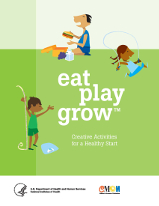My Five Senses
Early Childhood Health Lesson
Objective:
Learn to use the five senses in order to understand how to listen to the body’s nutrition and physical activity needs.
We Can! Messages
Importance of food choices.
Building a food vocabulary and knowledge base.
National Pre-K–2nd Grade Health Performance Standards
Identify how the family influences personal health practices and behaviors. Demonstrate healthy ways to express needs, wants, and feelings.
Adult Messages
Healthy habits begin at home and family is an influential factor.
It is important for children to develop an understanding and awareness of the five senses and how the senses influence and relate to food and food choices.
Developing Preschool Readiness Skills
Learn to identify body parts and learn about the five senses.
Program Content
Themed lesson plans incorporating art, literacy, movement, and music support a multi-disciplinary approach to teaching young children and adults.
Program Length: 70 minutes
Introduction/Discussion
Materials: Name stickers, markers
Welcome families with name stickers and “hello” song. When families are settled, ask: “Who eats?” Answer is EVERYONE! “What’s your favorite food? Why does everyone eat?” These three questions will help families think about their personal interests and guide families to discuss the importance of food for the body. If not offered, be sure to mention: Food gives us important nutrients that help our bodies grow strong; food gives us energy to learn, play, and live.
Once the importance of food is discussed, lead families through a discussion about how foods are different. Some foods are better for us, while some foods are not. How can we tell how they are different by using our five senses (taste, smell, touch, sight, and even sounds)? Guide children and families through each sense and the appropriate body part where is it located, what it does, how it helps us identify foods.
Can they remember what they have recently tasted, seen, heard, smelled, and touched? The idea will be to explore new foods and promote the fact that “eating a variety is healthy!” Senses can help us listen to what our body is telling us; help children build self-esteem, self-awareness, and communication skills as they describe being hungry or full.
Visual References: Pictures of eyes, ears, nose, hands, and mouth with sensory boxes for touch, sight, taste, sound, and smell.
Key Teaching Messages
- All bodies are unique and special.
- We have five senses to experience the world: taste, sight, smell, hearing, touch.
- You can control what goes in your mouth.
Art Activity: Five Senses Mask
Using a variety of collage materials children and adults will create unique masks that help build knowledge around the importance of using their five senses when making food choices.
Materials: Canvas mask and glue sticks (one for each parent), scissors, and collage materials like ribbons, feathers, felt, pipe cleaners, and pom-poms.
Set-up: Place a piece of tape on the back of the canvas mask so they can stick to the table. Place one canvas mask and glue stick at each seat. In the center of each table place one or two handfuls of each collage material (ribbons, feathers, felt, pipe cleaners, anti sequins, and pom-poms). They can be placed in piles or spread across the table. Make sure that each child can reach the materials. Have pre-cut strips of masking tape ready in case children want to make more than one project. Have a marker in hand to write the children’s names on their artwork when they are finished.
Clean-up: Give children a 5 minute warning. Always let children know that you will be transitioning and ending the project soon. After the warning, sing a clean-up song to focus children and encourage participation in the clean-up process. One example: “Clean up, clean up, one, two, three. I’ll help you and you help me. Clean up, clean up, one, two, three. I’ll help you and you help me.”
Physical Activity: Movement/Music
Weekly Structure: Warm-up, Active Play Time, Movement/Music (song/activity), Cool-down. Children should do at least 60 minutes (1 hour) or more of physical activity each day.
Warm-up:
Marching Movement Song
We’re marching, marching, marching We’re marching in a circle
We’re marching, marching, marching until it’s time to stop!
We’re jumping, jumping, jumping We’re jumping in a circle,
We’re jumping, jumping, jumping until it’s time to stop! (add hopping, stomping, running, tiptoeing, etc.)
In and Out Circle Song
Let’s go in and in
and in And out and out and out
And in and in and in and in
And out and out and out!
Active Play Time:
Do 5 or 10 minutes of each exercise
- Playing Tag
- Hopscotch
- Jumping Jacks
- Jumping (one foot, together then apart, front to back)
Movement/Music:
To highlight body awareness children and adults will participate in a series of Musical Movement Songs: Head, Shoulders, Knees, and Toes; Body Hokey Pokey; Simon Says; Five Senses Songs (see below).
Cool-down:
It is important for the body to cool down gradually.
- Breathing–Place hands on belly or lower back. Inhale and fill the lungs. Feel the abdomen and ribs inflate. Exhale and empty the lungs. Feel the chest and abdomen relax.
- Yoga Moves
- Downward Dog–Have the children make a bridge with their bodies. From here you can kick one leg up at a time and start to stretch body long.
- Tree Pose–Have the children balance on one leg, bending their other leg at a 90 degree angle, stretching their hands above their heads.
- The Horse–Stand in place for 30 seconds with a wide stance and knees bent (like a halfway down squat position).
Group Storytime
My Five Senses by Aliki
I Wonder by Harriet Fishel
Jamberry by Bruce Degen
Healthy Snack
Offer a variety of salty (taste; e.g., whole grain pretzels), sour (taste; e.g., lemon or dill pickles), sweet (smell and taste; e.g., oranges/clementines), sticky (touch; e.g., honey), smooth (touch; e.g., banana), crunchy (sound; e.g., sweet red pepper) and colorful (sight) foods that help discuss the five senses. An educator-led discussion will give children and adults the opportunity to learn more about how the five senses influence food choices. Discuss the importance of trying new foods and eating a variety of different foods to create a healthy, balanced diet.
Encourage children to wash hands with soap and warm water before eating snack. Hand Washing Strategy: Wash hands for 20 seconds to fight off all germs and then rinse well under running water. Sing the ABC Song while you wash.
Review Family Handout
Goal: Try three new fruits or vegetables with your child this week!
Facts of the Week: It can take 8–15 tries before children like eating new foods.
At-Home Strategies:
Offer one new food with familiar foods.
Try new foods when your child is rested and in a good mood.
Five Senses Songs
We All Have Five Senses
We all have five senses, senses, senses (Hold your five fingers out)
We all have five senses. 1, 2, 3, 4, 5
Eyes are for seeing, seeing, seeing (Point to your eyes)
Eyes are for seeing
We see with our eyes
Noses are for smelling, smelling, smelling (Point to your nose)
Noses are for smelling
We smell with our nose
Tongues are for tasting, tasting, tasting (Point to your tongue)
Tongues are for tasting
We taste with our tongues
Ears are for hearing, hearing, hearing (Point to your ears)
Ears are for hearing
We hear with our ears
Hands are for feeling, feeling, feeling (Rub your arms)
Hands are for feeling
We feel with our hands
We all have five senses, senses, senses (Hold your five fingers out)
We all have five senses. 1, 2, 3, 4, 5
The Five Senses Song
(Tune: “Old Mac Donald Had a Farm”)
On my face I have two eyes;
When I work and play.
With a look, look here,
And a look, look there,
Here a look, there a look,
Everywhere a look, look.
On my face I have two eyes;
Use them every day!
On my face I have a nose;
Use it all the time.
When I sniff it I can tell
Vinegar from lime.
With a sniff, sniff here,
And a sniff, sniff there,
Everywhere a sniff, sniff.
On my face I have a nose;
Use it all the time!
In my mouth I have a tongue;
Use it when I eat.
Tasting with it I can tell
Sour from the sweet
With a lick, lick here
And a lick, lick there
In my mouth I have a tongue;
Use it when I eat!
Five Senses
(Tune: “Where is Thumbkin?”)
Five senses, five senses
We have them. We have them.
They are used to help me see
Seeing, hearing, touching,
Tasting and smelling.
There are five. There are five.
Lesson Visuals
- Hand
- Head (side-view)
- Eyes, nose, ear, mouth, hands
Family Health Handout
My Five Senses
Benefits of Your Five Senses:
- All bodies are unique and special
- We have five senses to experience the world: taste, sight, smell, hearing, and touch
- You control what goes in your mouth
Farmers Market or Green Cart Shopping List
Pick one red fruit and one crunchy vegetable at your local market.
Family Goal
Goal: Enjoy your senses! Try three new fruits or vegetables with your child:
What does it look like?
1st Food
2nd Food
3rd Food
What does it smell like?
1st Food
2nd Food
3rd Food
What does it sound like?
1st Food
2nd Food
3rd Food
What does it taste like?
1st Food
2nd Food
3rd Food
What does it fell like?
1st Food
2nd Food
3rd Food
Fact of the Week
It can take 8–15 tries before children may like eating a new food.
Strategy
Offer one new food with familiar foods.
Surprising Fact
Your sense of taste is not just through your mouth; your nose is also an important tool for tasting.
Health Tip
Try new foods when your child is rested and in a good mood.
At-Home Tools
Body Books
My Five Senses by Aliki
I Wonder by Harriet Fishel
Jamberry by Bruce Degen
New Sense Words to Use
- Eyes: See
- Fingers: Touch
- Mouth: Taste
- Ears: Hear
- Nose: Smell
Did you know…
Offering a variety of foods to preschoolers helps children accept new foods and leads to healthier habits later in life.
Five Senses Activities
Taste Plate
Place three different foods on a plate. Help
children describe how each food tastes,
feels, and looks. Example: hard-boiled egg,
pineapple slices, and whole grain crackers.
Touch and Smell Surprise!
Take turns testing your senses. Close your
eyes and try to guess by touching what the
other player places in front of you.
Eye Spy!
The first player spies an object nearby and
gives the second player 3 hints to guess the
object. Example: I spy something that is
green, round, and small. (Answer: peas)
Delicious Recipes
Breakfast
Spread fat-free or low-fat cream cheese on
whole wheat toast and place apple slices (or
banana) on top.
Ladybug Pizza
On each half of an whole wheat English
muffin, place a slice of low-fat cheese and a
slice of tomato. Add raisins for the spots!
Creamy Salsa Dip
Combine salsa with fat-free or
low-fat cottage cheese. Cut up carrot
or celery sticks. Dip and enjoy!
| Back to Table of Contents | Back to Top |
NIH Publication No. 13-7818
April 2013











